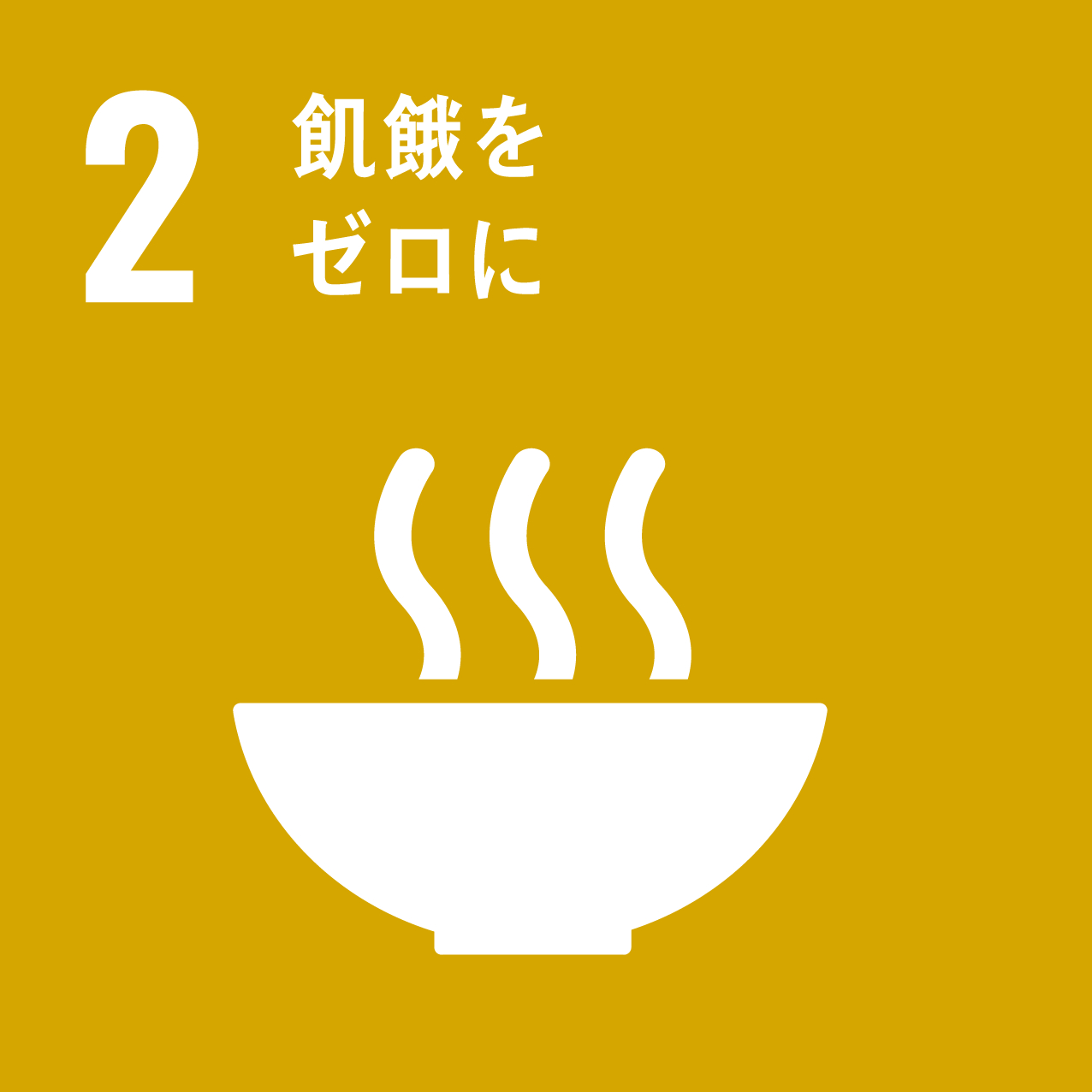目標 2 :飢餓をゼロに

(原文:End hunger, achieve food security and improved nutrition and promote sustainable agriculture.)
目標 2 を動画で解説
- 2 – 1 : 2030 年までに、飢えをなくし、貧しい人も、幼い子どもも、だれもが一年中安全で栄養のある食料を、十分に手に入れられるようにする。
- (原文:By 2030, end hunger and ensure access by all people, in particular the poor and people in vulnerable situations, including infants, to safe, nutritious and sufficient food all year round.)
- 2 – 2 :世界の国々が約束した、 2025 年までに、栄養がとれない、または栄養のバランスがよくないことによって、成長がさまたげられる 5 さい未満の子どもを減らす目標を達成するなどして、 2030 年までに、いろいろな形の栄養不良をなくす。妊娠していたり、赤ちゃんがいたりするお母さん、お年寄りの栄養について、よりよい取り組みを行う。
- (原文:By 2030, end all forms of malnutrition, including achieving, by 2025, the internationally agreed targets on stunting and wasting in children under 5 years of age, and address the nutritional needs of adolescent girls, pregnant and lactating women and older persons.)
- 2 – 3 : 2030 年までに、小規模の食料生産者(特に女性、先住民、家族農家、牧畜や漁業をしている人々)の生産性と収入を倍にする。そのために、土地や資源、知識を得たり、金ゆうサービスを使ったり、食料を売ったり、農業以外の仕事に就いたりするチャンスを平等に得られるようにする。
- (原文:By 2030, double the agricultural productivity and incomes of small-scale food producers, in particular women, indigenous peoples, family farmers, pastoralists and fishers, including through secure and equal access to land, other productive resources and inputs, knowledge, financial services, markets and opportunities for value addition and non-farm employment.)
- 2 – 4 : 2030 年までに、食料の生産性と生産量を増やし、同時に、生態系を守り、気候変動や干ばつ、洪水などの災害にも強く、土じょうを豊かにしていくような、持続可能な食料生産の仕組みをつくり、何か起きてもすぐに回復できるような農業を行う。
- (原文:By 2030, ensure sustainable food production systems and implement resilient agricultural practices that increase productivity and production, that help maintain ecosystems, that strengthen capacity for adaptation to climate change, extreme weather, drought, flooding and other disasters and that progressively improve land and soil quality.)
- 2 – 5 : 2030 年までに、作物の種子、栽培される植物、家畜の遺伝的な多様性を守る。そして、作物や家畜の利用に関して、人類がこれまでに生み出してきた知識や、そこから得られる利益を、国際的な話し合いのもと、公正に使い、分配できるようにする。
- (原文:By 2030, maintain the genetic diversity of seeds, cultivated plants and farmed and domesticated animals and their related wild species, including through soundly managed and diversified seed and plant banks at the national, regional and international levels, and promote access to and fair and equitable sharing of benefits arising from the utilization of genetic resources and associated traditional knowledge, as internationally agreed.)
- 2 – a :開発途上国、特に最も開発がおくれている国での農業の生産量を増やすために、国際協力などを通じて、農業に必要な施設や研究、知識の普及、技術開発や、遺伝子の保存(ジーン・バンク)に資金をだす。
- (原文:Increase investment, including through enhanced international cooperation, in rural infrastructure, agricultural research and extension services, technology development and plant and livestock gene banks in order to enhance agricultural productive capacity in developing countries, in particular least developed countries.)
- 2 – b :国際的な約束にしたがって、世界の農産物の貿易で、制限をなくしたり、かたよった取り引きをなくしたりする。
- (原文:Correct and prevent trade restrictions and distortions in world agricultural markets, including through the parallel elimination of all forms of agricultural export subsidies and all export measures with equivalent effect, in accordance with the mandate of the Doha Development Round.)
- 2 – c :食料の価格が極端に上がったり下がったりしてしまわないように、市場(マーケット)がきちんと機能するようにしたり、今どれだけの食料の備えがあるのかという情報を、必要な時に見られるようにしたりする。
- (原文:Adopt measures to ensure the proper functioning of food commodity markets and their derivatives and facilitate timely access to market information, including on food reserves, in order to help limit extreme food price volatility.)
子ども訳出典:(公財)日本ユニセフ協会「SDGs CLUB」
https://www.unicef.or.jp/kodomo/sdgs/17goals/2-hunger/
※日本ユニセフ協会の子ども訳をもとに、教育出版編集局で一部手を加えています。
目標 2 を実現するために、私たちができること。
- ①世界の飢餓について知ろう
-
- 世界では 11 人に 1人が飢餓に苦しんでいる(※出典「The State of Food Security and Nutrition in the World 2020 (FAO)」より)。
- 飢餓の主な原因として、自然災害や国内での争いによって食べ物となる作物を育てるのが難しいこと、開発途上国の農業の技術力が低く、作物を収穫できる量が少ないことなどが挙げられる。
- 世界各国が食べ物の支えんを行っているが、それと並行して持続可能な農業を実現するために、農業の技術を伝える支えんも行われている。
- できること
- 農業の技術を支えんしている日本の団体や会社について調べてみよう。
食べ物を支えんするだけだと、食べたらなくなっちゃう。だから、持続して食べ物を育てられるように、農業の技術を伝えることにしたんだよ。
- ②外国からきた食べ物について知ろう
-
- 日本の食料自給率は 40 %未満(※出典「日本の食料自給率(農林水産省)」より)。先進国の中では少ない。それでも食べ物が豊富にあるのは、外国から輸入しているからである。
- 私たちが口にしている食べ物は、どこで育てられたのだろう。それを知る手がかりとなるのが、生産地の表記である。ふだん、何気なく口にしている食べ物の多くが、外国から輸入した食べ物である。
- できること
- スーパーなどへ行ったとき、野菜、果物、肉類、魚類などの生産地はどこか見てみよう。商品によっては、生産者や生産地の情報が書かれているものもある。
日本では、年間 600 万トン(※出典「食品ロス量(平成 30 年度推計値)の公表(農林水産省)」より)の食べ物が、まだ食べられるのに捨てられているんだって。これを食品ロスというよ。食べ物が足りない国もあるのに、たくさん輸入してたくさん捨てていることについて、どう思うかな?